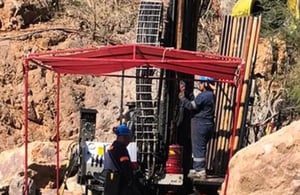European Metals Holdings Limited (LON:EMH) today reported on its activities and continued progress in the development of the globally significant Cinovec Lithium / Tin Project in Czech Republic during the three-month period ending September 2018.
Highlights:
· Average lithium carbonate production modelled to increase from 20,800tpa to 22,500tpa due to improved recoveries in the leach circuit of 94% being modelled.
· Increased lithium production results in projected increased cash margins of approximately 10%.
· Proposed use of low cost waste gypsum from local power plants as a roasting reagent is a significant positive environmental outcome for the region and a reagent cost benefit to the project.
· Locked cycle testing and larger scale roasting technology confirmation work to commence imminently.
· Preparation of 2 tonnes of lithium concentrate via magnetic separation for lithium carbonate pilot plant trials was almost complete.
PRODUCTION MODELLED TO INCREASE TO 22,500 tpa LITHIUM CARBONATE
The Company completed additional roast optimisation testwork early in the quarter and reported that sustained improved recoveries had resulted in a predicted increase in lithium carbonate production to 22,500 tpa from the project.
The Company reported that the optimised reagent mix developed during the testwork as compared to that reported in the PFS resulted in the elimination of all high cost inputs to the roast predicted previously. The mix now contains a higher proportion of gypsum but the gypsum takes the form of a waste material sourced from the scrubbing of power station off gases. The sample used during the development of this reagent regime was sourced from a power station in the region. Current indications are that this material would be available at a highly competitive price. Also, the PFS predicted the use of hydrated lime and sodium sulphate as relatively high cost reagents to the process, all of which have now been eliminated and replaced by the waste gypsum described, as well as a small addition rate of limestone which can also be sourced at competitive prices in the nearby regions.
These developments enabled the Company to initiate the next two phases of testwork. Firstly, involving locked cycle testing to confirm the flowsheet all the way through to the production of battery grade lithium carbonate and secondly, to enable larger scale roasting proof of technology testing to be completed in the next few months. The Company will also undertake the production of lithium hydroxide during the latter phase.
UPDATE OF PFS TO REFLECT PRODUCTION OF LITHIUM HYDROXIDE
The Company provided a project update on 4 September 2018, highlighting further significant advancements made in the development of the Cinovec project.
Highlights:
· Work had commenced on an update of the Preliminary Feasibility Study to model the production of higher value lithium hydroxide due to its increasing use in lithium ion batteries.
· Leach recoveries of 94-95% lithium had been replicated in confirmatory laboratory scale roasting and water leaching tests in Germany. Locked cycle testwork would then commence post the lithium hydroxide study to model the selected route.
· Permits had been granted for the commencement of geotechnical drilling at the project.
The Company announced the commencement of development of an updated Preliminary Feasibility Study (PFS) modelling the economics of the production of lithium hydroxide from Cinovec ore. The updated PFS included a process flowsheet whereby battery grade lithium hydroxide may be precipitated directly from the roast and water leach steps.
The Company also recommenced testwork at Dorfner Anzaplan in Germany. Initial testwork was focused on replicating results obtained in laboratory scale roasting testwork, reported on 28 March 2018 (Lithium Recoveries Improved to 95%). Similar results were achieved in 6 tests completed enabling the roasting feed blend and chemistry to be locked in and the stated recovery improvements to be used in future project and economic assessments. The plan was then to commence locked-cycle pilot testwork in September 2018 at Anzaplan with the selected lithium product (ie carbonate or hydroxide).
RESOURCE AND GEOPHYSICAL DRILLING PERMITS GRANTED LITHIUM HYDROXIDE TESTWORK COMMENCED
The Company announced further advancements made in the development of the Cinovec Project which highlighted:
· Permits required for the DFS resource drilling campaign had been granted.
· A total of 13 drill holes for a total drilled length of 3,386 metres had been permitted.
· The first 4 geotechnical drill holes at the proposed site of the mine portal had been completed.
· Testing of the revised lithium hydroxide product flowsheet had commenced on schedule.
The Company received permission from the relevant statutory authorities in the Czech Republic for the commencement of the planned comprehensive diamond drilling campaign. The drilling is aimed at converting a sufficient portion of the existing Indicated Mineral Resource to the Measured Resource category to cover the first 2 years of the scheduled mining plan. A total of 8 diamond drill holes will be completed for 2,560 metres. This is a key activity in terms of the ongoing ramp up of the project’s definitive feasibility study (DFS).
The Company also reported the completion of the initial 4 geotechnical holes reported on 4 September 2018 (CINOVEC PROJECT UPDATE – SIGNIFICANT ADVANCEMENTS), for the portal area. Geotechnical logging of the four holes was planned to be completed in early October 2018. The rig would then continue with drilling a further five geotechnical holes along the planned mining decline route to allow final development ready designs to be completed for the portal and decline designs.
European Metals also reported that testwork at Dorfner Anzaplan in Germany had commenced on schedule. The first stage of the testwork was focused on proving up a flowsheet developed for the production of lithium hydroxide. It is the intention that this work would be followed by locked cycle testing of the flowsheet settled upon.






































